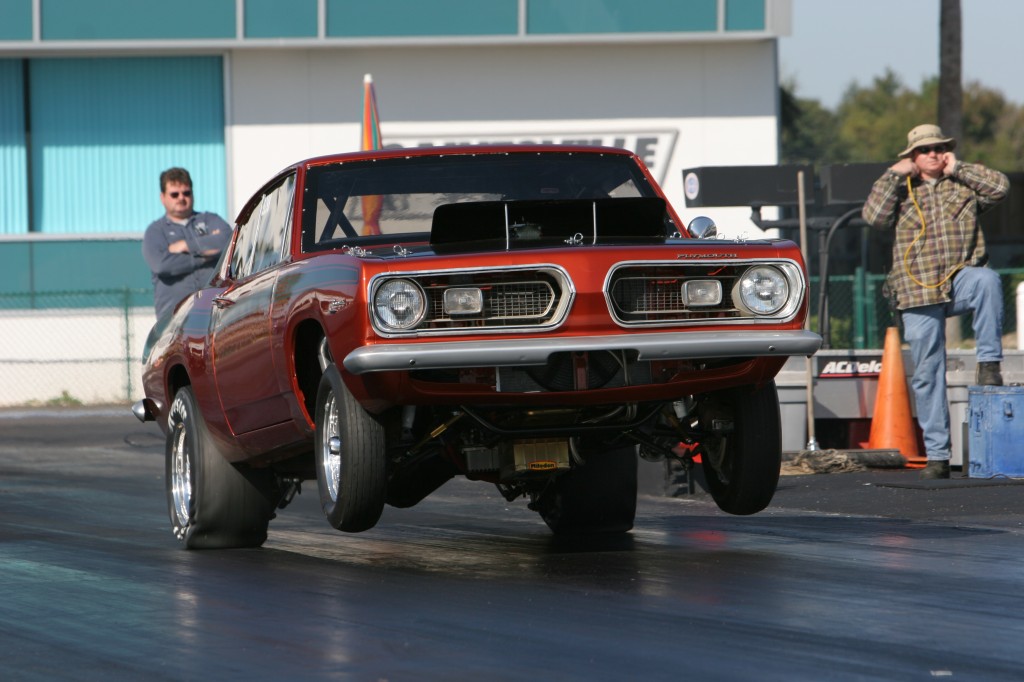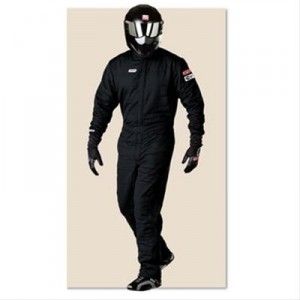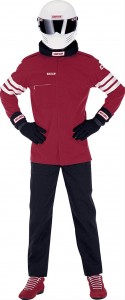Racing season is nearly upon us.
Now is the perfect time to revisit the importance of choosing the right racing suit. Whether you’re an entry-level grassroots racer or professional Top Fuel driver, the right driving suit will help you live to race another day.
So what is the right driving suit?
It really comes down to finding the right balance between safety, comfort, and budget. To help you strike that perfect balance, we consulted with the experts at Impact Racing and Simpson Racing to identify six key things to consider when choosing a racing suit. Not surprising, it’s safety first.
Safety Ratings
Safety ratings and racing suit design are often intertwined. For that reason, it’s important to know your sanctioning body’s requirement for SFI (United States) or FIA (International) ratings.
Used in sanctioning bodies like NHRA and NASCAR, the SFI Foundation’s racing suit specification 3.2A tests a material’s fire retardant capabilities. This specification is based on the garment’s ability to provide thermal protective performance (TPP) against radiant heat and direct flame. The TPP is derived by performing a test procedure that exposes fabric to two different heat sources. Using this test and a mathematical calculation, a number value is assigned to create the TPP value. This value is divided in half to determine the amount of seconds it would take for the material to allow a second degree burn.
The higher the garment rating, the better the material.
This chart spells it all out:
Thermal Protective Performance Chart
| SFI Rating | TPP Value | Time to 2nd Degree Burn | Typical Use |
|---|---|---|---|
| 3.2A/1 | TPP 6 | 3 Seconds | Single-Layer Suit |
| 3.2A/3 | TPP 14 | 7 Seconds | Double-Layer Suit |
| 3.2A/5 | TPP 19 | 10 Seconds | Double-Layer Suit |
| 3.2A/10 | TPP 38 | 19 Seconds | Land Speed Records |
| 3.2A/15 | TPP 60 | 30 Seconds | Top Fuel/Alcohol |
| 3.2A/20 | TPP 80 | 40 Seconds | Top Fuel/Alcohol Funny Car |
Click here for a handy downloadable PDF version of the racing suit thermal protection chart above.
Again, you’ll need to verify your racing sanctioning body’s rules to adhere to the proper SFI rating. The most common requirement by racing circuits is the SFI 3.2A/5 rating; however, alcohol or nitro drag racing often require suits that meet the 3.2A/15 or 3.2A/20 spec.
Likewise, FIA is the European association that issues safety standards for international race cars and equipment. Consult your race sanctioning body for your specific requirements.
Racing Suit Materials
As we mentioned, SFI rating and driving suit design are often related.
Budget and sanctioning body rules can play a role when choosing your racing suit material. The most common materials used on racing suits are treated cotton fabrics and Nomex®. Treated cotton driving suits are often less expensive, but the chemical treatment can begin to lose effectiveness after each cleaning. That means often times the lifespan of treated cotton fabrics are shorter than other materials.
Nomex is inherently flame resistant so its effectiveness cannot be washed out. Nomex will not sustain combustion in air or melt when exposed to flame. In fact, it actually carbonizes and becomes thicker when exposed to intense heat, forming an additional protective barrier between the heat source and skin.
Nomex-based driving suits typically provide the greatest protection against fire and heat and meet the highest SFI standards. Other materials used in racing suits include gabardine, proban, and Cordura; however, it’s important to make sure the intended purpose and safety rating of your racing suit matches your sanctioning body.
“Cordura suits are typically made specifically for karting as they have abrasion resistance; however, they are not fire retardant,” said Kelli Willmore, vice president of marketing at Impact and Mastercraft Safety. “Many new and entry level racers do make the mistake of purchasing a non-fire retardant karting suit for circle and drag racing because of the much lower cost – only later to realize that their suit will not pass the required tech as it does not meet the SFI specs.”
Proper Racing Suit Size
Proper sizing is one of the most important factors in choosing a racing fire suit. It’s not only essential for comfort and performance; it’s also a safety factor.
You’ll need to take various measurements to ensure you get the right size racing suit. These measurements typically include height, weight, chest, waist, hips, and more. Most size charts will look like this one from Impact Racing.
Standard Firesuit Sizing
| Size | Height | Weight (lbs.) | Chest | Waist | Hips | Torso | Inseam |
|---|---|---|---|---|---|---|---|
| Adult Small | 5'4" - 5'6" | 130 - 150 | 38" - 40" | 29" | 33" | 27" | 31" |
| Adult Medium | 5'6" - 5'8" | 150 - 170 | 42" - 44" | 32" | 36" | 28" | 31" |
| Adult Large | 5'8" - 5'10" | 170 - 190 | 46" - 48" | 36" | 40" | 29" | 32" |
| Adult Extra Large | 5'10" - 6'1" | 190 - 210 | 50" - 52" | 39" | 44" | 31" | 33" |
| Adult 2X-Large | 6' - 6'2" | 220 - 240 | 54" - 56" | 39" | 47" | 32" | 33" |
| Junior Small | 4'1" - 4'4" | 50 - 65 | 27" - 29" | 23" | 26" | 19" | 22" |
| Junior Medium | 4'3" - 4'7" | 70 - 90 | 28" - 30" | 25" | 27" | 21" | 25" |
| Junior Large | 4'5" - 4'9" | 80 - 100 | 34" - 36" | 27" | 31" | 23" | 27" |
| Junior Extra Large | 4'7" - 4'11" | 90 - 120 | 35" - 37" | 28" | 32" | 25" | 29" |
Click here for a downloadable PDF of the racing suit fitment and sizing chart above.
Ideally, you’ll want your racing suit to allow for a layer of air between your body and the suit. This layer of air acts as an insulator and provides extra protection in the event of a fire. It also allows the body to naturally cool itself more effectively during the high temperatures of summer racing season. Companies like Impact Racing even offer a layer of quilting on multi-layer suits to create air pockets, which help improve air circulation under the suit.
Once you have your measurements, be sure to pay attention to the specific size chart of the brand from which you are buying. There can be subtle variances between manufacturers.
Single vs. Multi-Layer Racing Suits
Here is where you need to strike that balance between safety and comfort.
Typically, more layers mean more protection. A two- or three-layer suit is more resistant to flame and heat transfer and will give you extra time during an emergency situation versus a single-layer driving suit. What’s more, a multi-layer racing suit is absolutely imperative for the type of racing you do (see the SFI chart above).
However, added layers can mean added bulk.
You can find lighter weight, better breathing multi-layer suits, but these can be expensive. Again, you need to consider your budget and safety needs and err on the side caution.
Safety first.
One vs Two-Piece Racing Suits
What about one and two-piece driving suits?
One-piece suits not only provide increased safety over multi-piece garments, they are sometimes required. According to Simpson Racing, one-piece racing suits are mandatory for all NASCAR drivers and fuelers. The reason is simple: There can sometimes be a gap between the jacket and pants on two-piece suits, exposing the user to possible burns.
Still, many two-piece auto racing suits meet 3.2A/5 specifications, so they’re often used by drag racers. They are also approved for use by NASCAR crew members who do not handle fuel. Advantages of two-piece suits include increased mobility and easier removal when comfort is a factor.
The Right Undergarments
There’s more to choosing the right undergarment for your driving suit than you think.
Impact Racing and Simpson Racing both point out the dangers of using the compression-style athletic undergarments you often see used in football, basketball, and other sports. These items use petroleum-based or synthetic blends to wick away moisture and promote cooling.
Sounds good, right?
Unfortunately, the nylon, elastane, or polyester used in these garments melt when ignited.
“One of the worst items we see is synthetic garments being worn under suits,” Willmore said. “This type of undergarment is manufactured from a material that, when heated, melts and drips and is tremendously painful for the wearer. This was such a common problem during Iraq and Afghanistan that the US Armed Forces actually banned the use of these type of garments in conflict zones.”
According to Simpson Racing, the National Fire Protection Association also banned this material from being worn under turnout gear. That’s why Simpson Racing and Impact Racing, along with other safety equipment manufacturers, offer Nomex undergarments to provide an added level of protection against heat and fire. We absolutely recommend the use of a Nomex undergarment, especially under a single-layer suit.
The right racing suit and safety accessories will not only keep you protected, but they’ll help you race with confidence.
And confidence breeds success.





SPARCO has introduced a line of drivers suit made from Hocotex which offers SFI 3.2a/5 protection in a single layer suit.
From SPARCO’s website: “The Eagle RS-8.2 is the result of over 3 years of research and development. Sparco has patented a new technology called HOCOTEX® which revolutionizes the way racing suits are made. This new exclusive Sparco technology creates a single layer fabric which has the protection of what is normally achieved by a multi-layer fabric. The Eagle RS-8 is FIA 8858-2000 homologated.”
Your Opinion please.
my husband drag races.. he is needing a new suit. If he goes turns and uses alcohol in his truck does he have to have a special suit for that?
Yes he does. I believe it’s a minimum of SFI15 jacket and pants or suit. If he’s running a power adder, than a SFI 20 suite is a good idea. NHRA rules outline it pretty well albeit hard to find in print.
Very interesting and educational
Thank you
I own Motion Designs Safety Apparel and offer stock Nomex and custom Taylor SFI Certified suits
Tom,
Do you have a website?
[…] Download Image More @ http://www.onallcylinders.com […]
Can I have your free magazine and sticker?
This is my address:
LELLO ORAZZO
VIA PETRARO 383
80050 SANTA MARIA LA CARITA’ (NA)
Thank you very much
I’m looking for singles layer fabrics that are naturally FR. I don’t need a high rated 1 just would like to have my base layer FR. I am also looking for gloves that have the highest touch heat rating. that way I can be achieve a little more then the minimum requirements for most hot work related applications.
[…] is another topic we’ve covered before in a standalone article, but this video is packed with a ton of more information, including direct quotes from race […]